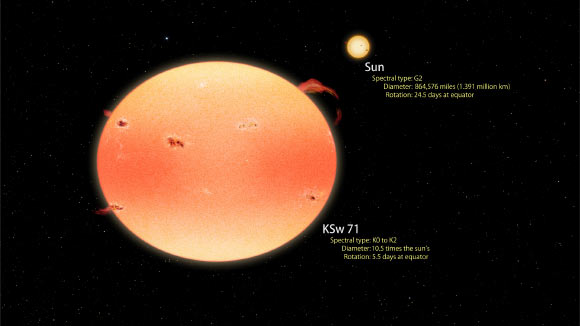
Artist’s rendering, shown to scale.
Using observations from NASA’s Kepler and Swift space observatories, astronomers have spotted 18 fast-spinning stars that produce X-rays at more than 100 times the peak levels ever seen from the Sun.
“These stars rotate in just a few days on average, while the Sun takes nearly a month. The rapid rotation amplifies the same kind of activity we see on the Sun, such as sunspots and solar flares, and essentially sends it into overdrive,” explained team leader Dr. Steve Howell, from NASA’s Ames Research Center.
The most extreme member of the group is called KSw 71, a K-type orange giant star more than 10 times larger than our Sun. It rotates in just 5.5 days, about four times faster than the Sun. Because of its rapid rotation, it has flattened into a pumpkin shape, resulting in brighter poles and a darker equator. The rapid rotation also causes increased levels of activity such as starspots and flares, creating X-ray emission over 4,000 times more intense than the peak emission from the sun. The star probably formed recently as the result of a merger of two Sun-like stars in a close binary system.
This group of stars was found as part of the Kepler-Swift Active Galaxies and Stars Survey (KSwAGS), an X-ray survey of the so-called Kepler field, a patch of the sky comprising parts of the constellations Cygnus and Lyra. According to Dr. Howell and his colleagues, the NASA Kepler mission was launched in 2009 and completed four years of photo observation of over 150,000, mainly late-type stars. The team conducted the survey using the Swift X-ray telescope.
“We were looking for variable X-ray sources with optical counterparts seen by Kepler, especially active galaxies, where a central black hole drives the emissions,” said team member Dr. Padi Boyd, from NASA’s Goddard Space Flight Center.
“With KSwAGS we found 93 new X-ray sources, about evenly split between active galaxies and various types of X-ray stars,” added team member Krista Lynne Smith, from the University of Maryland, College Park. “Many of these sources have never been observed before in X-rays or ultraviolet light.”
The team also used Kepler measurements to determine the rotation periods and sizes for 10 of the stars, which range from 2.9 to 10.5 times larger than the Sun. Their surface temperatures range from somewhat hotter to slightly cooler than the Sun.
Astronomers classify the stars as subgiants and giants, and all of them will eventually become much larger red giant stars.
In the 1970s, Dr. Ronald Webbink at the University of Illinois, Urbana-Champaign noted that close binary systems cannot survive once the fuel supply of one star dwindles and it starts to enlarge.
The stars coalesce to form a single fast-spinning star initially residing in a so-called ‘excretion’ disk formed by gas thrown out during the merger. The disk dissipates over the next 100 million years, leaving behind a very active, rapidly rotating star.
The astronomers suggest that their 18 KSwAGS stars formed by this scenario and have only recently dissipated their disks.
Read more here.